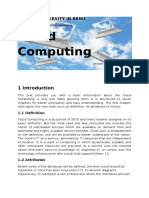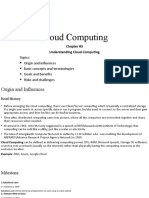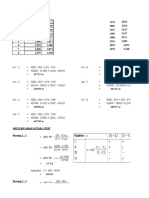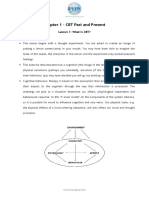0% found this document useful (0 votes)
78 views38 pagesChap-1 - Understanding Cloud Computing
The document provides an overview of cloud computing concepts, including its origins dating back to utility computing in the 1960s. It discusses how technologies like clustering, grid computing, and virtualization influenced the development of cloud computing. Key terms are defined, such as cloud referring to a distinct IT environment for remotely provisioning scalable IT resources. Cloud providers make these resources available, while cloud consumers utilize them. Scaling is the ability of an IT resource to have its capabilities increased or decreased depending on demand.
Uploaded by
رزان محمدCopyright
© © All Rights Reserved
We take content rights seriously. If you suspect this is your content, claim it here.
Available Formats
Download as PDF, TXT or read online on Scribd
0% found this document useful (0 votes)
78 views38 pagesChap-1 - Understanding Cloud Computing
The document provides an overview of cloud computing concepts, including its origins dating back to utility computing in the 1960s. It discusses how technologies like clustering, grid computing, and virtualization influenced the development of cloud computing. Key terms are defined, such as cloud referring to a distinct IT environment for remotely provisioning scalable IT resources. Cloud providers make these resources available, while cloud consumers utilize them. Scaling is the ability of an IT resource to have its capabilities increased or decreased depending on demand.
Uploaded by
رزان محمدCopyright
© © All Rights Reserved
We take content rights seriously. If you suspect this is your content, claim it here.
Available Formats
Download as PDF, TXT or read online on Scribd
/ 38





















































































